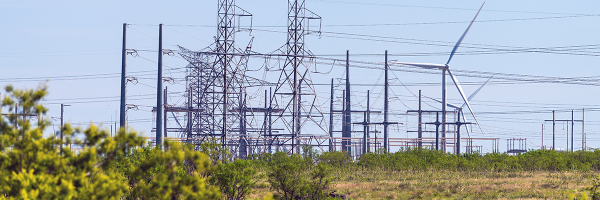Shopping for electricity plans in Texas can seem confusing, but we’re here to help! Even before you implement energy savings tactics or make improvements to your home, you should find the right provider for your needs. Here are some tips for navigating the wild west of energy.

Why You Need to Choose an Electricity Provider
Because the electricity market is deregulated in Texas, you need to choose between Retail Electricity Providers (REPs) who want your business, and will often market to you with plans and promotions that sound great, but might not save you money in the end.
The first thing to understand is that technically you are paying every month for energy from the utility and for delivery from the provider. The utility (Transmission and Distribution Utility, or TDU) charges to maintain power lines and infrastructure, and according to the Public Utility Commission of Texas, by law they cannot shut off power when you switch providers. As a side note: because they are responsible for maintaining the grid, in the event of a power outage, you should contact your utility rather than your provider.
To get electricity to your home, the provider (REP) buys power on the wholesale market and sells it to you. When you start shopping for plans, this is important to note: some REPs will “bundle” the utility and provider charges into a combination rate; others break out the energy charges separately. When you’re choosing a provider, make sure that you’re considering the total cost of energy + delivery.
It’s also good to remember that you can switch providers at any time, so you don’t have to stick with the plan you’ve got (or that you inherited from a landlord or previous tenant), although there might be a fee for breaking a contract. Also, note that switching won’t cause your power to go out – changing your provider does not impact your service reliability.
Energy Prices Fluctuate
Electricity rates in Texas range from around 12-14 cents per kWh, for the lowest standard 1,000 kWh monthly usage. Remember that rates typically go up in the summer and decrease as temperatures cool off in the winter months. The U.S. Energy Information Administration predicts that in 2024, energy prices overall for homes may decrease, although bear in mind that these prices fluctuate based on market prices.
Most of the electricity produced and used in our state comes from natural gas, and the price of gas varies based on supply and demand. Nuclear, solar, and wind energy are also major contributors to our energy production, and as capacity grows in these areas prices could decrease.
Prices are calculated based on flat rates or tiered rates, which are different prices for different amounts of usage. With tiered rates, when usage increases over the billing term, customers progress from the lower priced usage block (called the baseline) to higher priced blocks. Time of use rates, on the other hand, have different prices for when energy is used – lower for off-peak hours, higher for high demand times.
When a REP quotes a price for energy, all of these factors come into play.
Three Types of Energy Rates
When choosing a plan, you have three options: fixed, variable or indexed rate.
Fixed rate plans are negotiated based on your predicted usage and you pay the same rate every month for the lifetime of your contract (typically 12-36 months). Retailers estimate how much they will pay for the electricity you use, taking into consideration the price of natural gas, weather events, and so on. Then they add a safety margin so they don’t undercharge you and lose money. These plans are popular because they allow you to budget for energy costs and know that the only things that change are your energy usage and government fees or taxes.
If you’re looking to avoid a long-term contract, a variable rate plan may be right for you. With this type of plan there’s no contract, and with this month to month electricity plan you can switch your provider or plan without penalty. That said, your monthly bill will go up or down based on market prices and changes in demand, which can lead to unexpected hikes in your bill.
Indexed plans rates are calculated based on market indices like the price of natural gas, which may be based on spot or future prices. Some larger users of energy (like manufacturers) take advantage of the fact that electricity pricing moves up and down with the energy market, for example if there is a market downturn or off-peak period when energy prices are lower.
Be aware that if you have a credit score under 600, some plans may require a deposit of 2 months worth of your estimated bill. So check to see if there are no-deposit plans available. And prepaid plans not only let you sign up without a deposit or credit check, they have you pay for your electricity before you use it.
Whichever way you go – fixed rate for certainty when it comes to your bill, or other options based on a desire to capture potential savings based on market fluctuations, be sure to carefully review your contract and watch out for hidden fees.
Smart Electricity Shopping: A Step-by-Step Guide
The short version? Know your home’s range of monthly usage, and then compare the total cost of plans while checking for additional or unnecessary monthly energy fees and marketing gimmicks.
Start by knowing your current electricity rate, so you can compare prices offered by other providers. Be sure that you are considering the total rate, for both energy and delivery, so you can compare apples to apples.
Then check your past energy bills to find out your average monthly electricity usage – which are based on 500 kWh, 1000 kWh and 2000 kWh usage. Obviously, your monthly usage changes throughout the course of the year, with summer’s demand for air conditioning being the major player in high summer usage.
Don’t worry about having the numbers be exact, because you’re looking to predict usage in the coming year – and unless you’ve made major changes to your home, then the past year’s usage should be a good indicator of future need. If you have a smart meter, then put technology to work for you! It can help you track and even manage your electricity use.
Next, shop where you can compare your total costs across each of the twelve months. Providers will provide a rate by kWh, and you can make your selection based on the cost. Be sure to understand all of the details, including any additional costs and fees before you sign a contract: review the Electricity Facts Label, which comes with every plan, for details such as rate type, percentage of renewable energy, fees for delivery, and more.
Evaluating Providers Beyond Price
We recommend choosing a provider with transparent pricing – at Rhythm Energy, not only do we have fair and transparent pricing, we also give weekly usage reports and bill prediction to help take the guesswork out of your electricity bills.
Reputation is also a key factor. Search out and read reviews of potential providers; your neighbors who have had great (or poor) experiences can offer great insight into what kind of service you can expect!
What About Renewable Energy Plans?
According to the U.S. Office of Energy Efficiency and Renewable Energy, clean energy is better for our shared planet than fossil-fuel based power production like coal, natural gas, and petroleum oil. Electricity generated by solar, wind and water do not produce toxic emissions that contribute to climate change – which in turn contribute to droughts, wildfires, flooding, and other catastrophes.
Renewable energy like solar and wind farms do require land to support their infrastructure, but they have a much smaller geographic footprint and lower impact than fossil fuel production facilities. For instance, solar panels can be installed on buildings that already exist, and wind turbines can be set up on farms without harming crops.
Another encouraging fact about renewable energy is that the prices for this kind of energy are dropping. In many parts of the world, renewable energy is the cheapest power option available – the cost of solar electricity fell by 85% between 2010 and 2020, and the costs of wind energy fell by around 50%. Here in Texas, with the production of renewable energy on the rise, prices will continue to go down.
Whatever provider and plan you choose, it’s a good thing to make sure that it works for your budget and your lifestyle. We love it when our customers love the power they get, and control over their bill that they feel, when they switch to Rhythm Energy. In the words of one customer, Amanda S.: “I switched to Rhythm Energy because I was looking for an energy company that is straightforward and is not trying to wow me with introductory offers. I learned that Rhythm Energy has the same rates for everyone whether you’re renewing or signing up for the first time. It was easy to switch so I did.”



